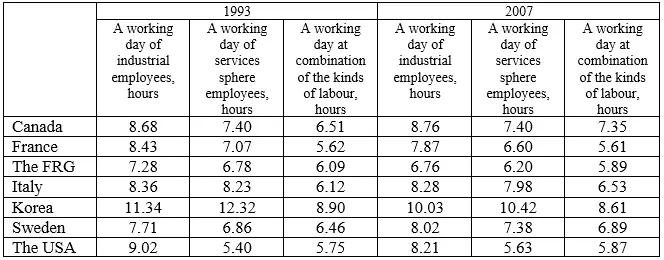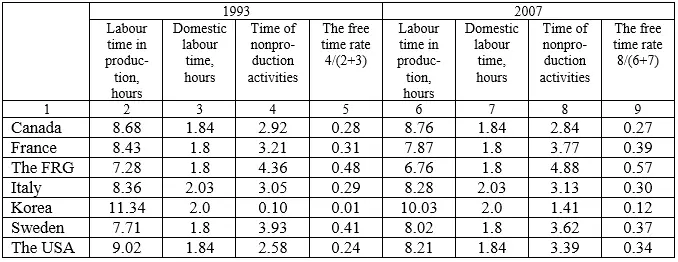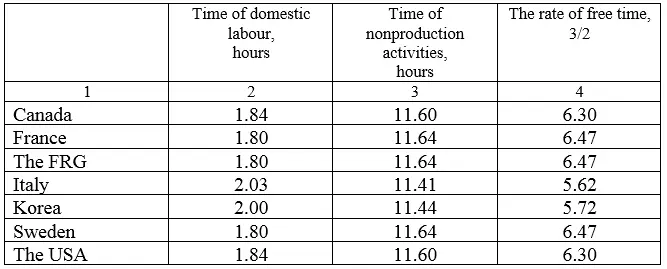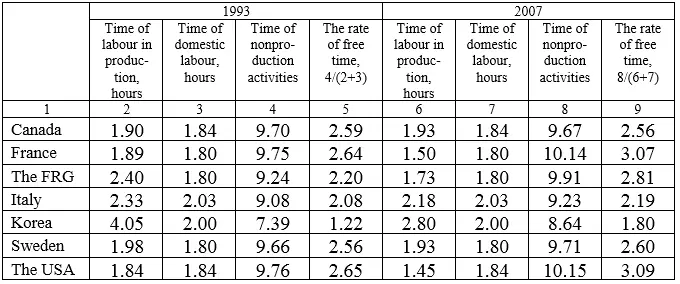By 2007 the situation would change differently: in France, the FRG, and Korea general working time duration would reduce, in the rest of the countries it would increase. At that, the part of time spent on labour in the services sphere would increase at employees of all the countries. It would mean that each able-bodied person would spend more and more time on activities richer in content and fulfilled in more favorable conditions than labour in production every day.
In the context of our research “rendering services” means fulfilling all kinds of labour that is not immediately production. For example, it concerns functions of state governing too, so that participation in governing would become actually universal.
The above-mentioned data correspond to the prerequisite of daily distribution of labour in production and the services sphere in constant proportions, got when calculating average values. It is quite possible that organization of production would require distribution of working time in a bit different proportions, so that shift duration would be 1.5-2 hours (but not 1.73, 1.93 hours, etc.). It is possible to correct duration of rendering services in the same way. Such variations in duration of the components of a working day would not abolish social economic equality of members of the society in respect of fulfilment of economically heterogeneous kinds of labour.
Let us compare working day duration at conservation of old division of labour to working day duration in conditions of overcoming division of labour.
Table 38
Working Day Duration of Employees of the Production, Nonproduction Spheres and Combining Production Activities and Rendering Services (Calculated According to the Data on Labour Expenditures and Employment in 1993 and 2007)

Industrial employees’ working day is the most enduring. Korea is exclusion, but working time per day in the nonproduction sphere reduced faster than in production there. Average daily labour time of services sphere employees is, in general, less enduring than industrial employees’ one but it exceeds the working day value at combination of labour in production with rendering services. Consequently, at old division of labour a working day both in production and the nonproduction sphere is more enduring than it is objectively possible at combination of economically heterogeneous kinds of labour by all able-bodied people. Accordingly, exactly in the conditions of social economic equality able-bodied members of the society would dispose of the highest value of nonworking time in the period of working days, and that is why they would have additional opportunities for their development at leisure.
For a more accurate assessment of the volume of daily nonworking time and, in general, time for free development it is necessary to take into account the daily rate of free time. It is about its value related to those days of a week when labour on satisfaction of social needs is fulfilled (accordingly, weekends, holidays, and leaves are excluded).
The Daily Free Time Rate of Industrial Employees
For calculation of the daily free time rate it is necessary, first of all, to calculate time spent on social activities.
Table 39
The Daily Free Time Rate of Industrial Employees

According to the time budget of the USA let us take time of satisfaction of physical needs as 10.56 hours, then 13.44 hours remain for social activities. From the mentioned-before data the rate for industrial employees can be calculated.
When examining the obtained data, it should be taken into consideration that time spent on domestic labour at working days is less enduring than at weekends. In the made calculations the average value levelling this difference is taken. Consequently, the data on domestic labour expenditures are a bit overrated. Obviously, the prerequisite of the identical number of weekends and leaves in Korea to similar indices of the rest of the countries is not quite correct too: the less number of such days in Korea reduces working time duration per day and increases nonworking time a bit. In spite of the mentioned restrictions the data allow assessing the level of the daily free time rate.
Obviously, the daily free time rate of industrial employees is 2-3 times less than one. It is seriously behind the annual rate because the latter includes time of nonproduction social activities at weekends, holidays, and leaves. Thereby, during working days the fact of social economic fixation of these members of the society in fulfilment of production labour shows more brilliantly. Certainly, their state differs from the state of slaves whose time of production labour absorbed not only the biggest part of a day but a part of time necessary for satisfaction of physical needs. At the same time, this difference is not so essential for cancelling old division of labour, originated in the epoch of slave-owning.
At the present tempos of working day reduction in social production and daily labour in housekeeping 60-70 years are needed for the daily free time rate of industrial employees to approximate to 1, but it will be not enough for ensuring needs for their free, all-round development. The matter is that it is the nominal rate including time spent on movement, standing in queues, etc., the time that is, by the essence, a deduction from free time.
For a more complete picture of the character of modern economic development it is necessary to take into consideration the level of the daily free time rate of employees occupied in the nonproduction sphere.
The Daily Free Time Rate of Nonproduction Sphere Employees
The daily free time rate of services sphere employees is determined as a ratio of their nonproduction social activities, including paid rendering services, and time of labour in housekeeping. As it was mentioned before, time of such labour is constant for the examined period.
Nonproduction sphere employees’ free time rate is many times higher than at industrial employees (table 40). It cannot be otherwise in conditions when the first ones do not participate in paid production labour.
Table 40
The Daily Free Time Rate of Nonproduction Sphere Employees

Undoubtedly, this category of employees disposes of much more favorable daily conditions for their development than employees occupied in social production. But one should not forget that services sphere employees are in such favorable conditions because production labour is fulfilled by another social group, the daily free time rate of which remains lower than 0.5 in most cases.
To understand the potential of modern economic development it is reasonable to fix the daily free time rate for employees who would combine labour in production with rendering services (table 41).
Table 41
The Daily Free Time Rate of Employees Combining Labour in Production with Rendering Services

Combination of economically heterogeneous kinds of labour by all able-bodied people ensures everyone with the daily free time rate exceeding 2 (except for Korea). Moreover, there is a tendency to increasing in this value, conditioned on equal distribution of labour saving among employees from increasing in its productivity. Consequently, the potential of the modern economy is quite sufficient, so that all members of the society could daily spend the prevailing part of their time on fulfilling nonproduction social activities which are, in general, richer in their content and fulfilled in more favorable conditions.
Читать дальше
















